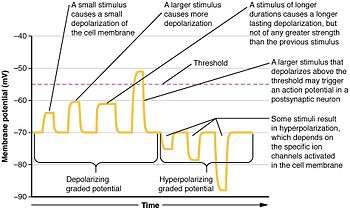Graded potential
Graded potentials are changes in membrane potential that vary in size, as opposed to being all-or-none. They include diverse potentials such as receptor potentials, electrotonic potentials, subthreshold membrane potential oscillations, slow-wave potential, pacemaker potentials, and synaptic potentials, which scale with the magnitude of the stimulus. They arise from the summation of the individual actions of ligand-gated ion channel proteins, and decrease over time and space. They do not typically involve voltage-gated sodium and potassium channels.[1] These impulses are incremental and may be excitatory or inhibitory. They occur at the postsynaptic dendrite in response to presynaptic neuron firing and release of neurotransmitter, or may occur in skeletal, smooth, or cardiac muscle in response to nerve input. The magnitude of a graded potential is determined by the strength of the stimulus.

EPSPs
Graded potentials that make the membrane potential less negative or more positive, thus making the postsynaptic cell more likely to have an action potential, are called excitatory postsynaptic potentials (EPSPs). Depolarizing local potentials sum together, and if the voltage reaches the threshold potential, an action potential occurs in that cell.
EPSPs are caused by the influx of Na+ or Ca2+ from the extracellular space into the neuron or muscle cell. When the presynaptic neuron has an action potential, Ca2+ enters the axon terminal via voltage-dependent calcium channels and causes exocytosis of synaptic vesicles, causing neurotransmitter to be released. The transmitter diffuses across the synaptic cleft and activates ligand-gated ion channels that mediate the EPSP. The amplitude of the EPSP is directly proportional to the number of synaptic vesicles that were released.
If the EPSP is not large enough to trigger an action potential, the membrane subsequently repolarizes to its resting membrane potential. This shows the temporary and reversible nature of graded potentials.
IPSPs
Graded potentials that make the membrane potential more negative, and make the postsynaptic cell less likely to have an action potential, are called inhibitory post synaptic potentials (IPSPs). Hyperpolarization of membranes is caused by influx of Cl− or efflux of K+. As with EPSPs, the amplitude of the IPSP is directly proportional to the number of synaptic vesicles that were released.
Summation
The resting membrane potential is usually around –70 mV. The typical neuron has a threshold potential ranging from –40 mV to –55 mV. Temporal summation occurs when graded potentials within the postsynaptic cell occur so rapidly that they build on each other before the previous ones fade. Spatial summation occurs when postsynaptic potentials from adjacent synapses on the cell occur simultaneously and add together. An action potential occurs when the summated EPSPs, minus the summated IPSPs, in an area of membrane reach the cell's threshold potential.
Notes
- Hille 2001, pp. 169–200. "Chapter 6. Ligand-gated channels of fast chemical synapses."
References
- Hille, Bertil (2001). Ion Channels of Excitable Membranes (3rd ed.). Sunderland, Massachusetts: Sinauer. ISBN 0-87893-321-2.